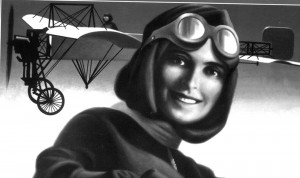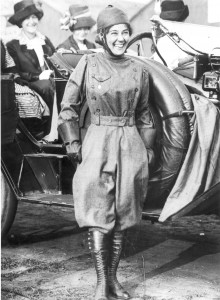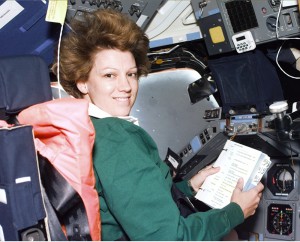By Henry M. Holden

Harriet Quimby lost her life when her Bleriot XI tossed her and her passenger out of the airplane at 2,000 feet.
On July 9, 1903, five months before the Wright brothers made their historic flight, Cuban-born American, Aida de Acosta, soloed in a dirigible outside Paris, France.
After the Wright brothers’ first powered flight in a heavier-than-air machine, the French rose to the leadership role in world aviation. In 1910, Raymonde de la Roche, of France, became the first woman in the world to earn a pilot’s license. In the United States, however, prominent men in aviation, like the Wrights, refused to let women fly.
“I was annoyed from the start by the attitude of doubt by the spectators that I would never really make the flight. This attitude made me more determined than ever to succeed,” said Harriet Quimby, the first American woman to earn her pilot’s license, in 1911.
Quimby, like many aviators of the day, didn’t have a long expected life span. The more often they flew the dangerous and unstable aircraft, the greater the odds they would have a fatal aircraft accident. Quimby did what she loved to do, and paid the price many of her contemporaries also paid. The first woman to solo the English Channel, she died in an aircraft accident 11 months after she had earned her license.
Published posthumously, in 1912, was her prediction: “The aeroplane should open a fruitful occupation for women. I see no reason they cannot realize handsome incomes by carrying passengers between adjacent towns, from parcel delivery, taking photographs or conducting schools of flying.”

The heavy tweed flying suit Matilde Moisant wore saved her life in her fourth and last accident. The ensuing fire burned only the exposed parts of her skin.
Quimby was right. Over the past 100 years, women have played a significant role in the development of aviation in America. They endured prejudice, economic disadvantage and segregation, and still succeeded in their dreams. But, it is only in the last decade that public awareness has grown around their contributions.
Quimby’s friend Matilde Moisant quit flying after four nearly fatal accidents, and lived into her eighties. But, many aviators who followed Quimby, like Bessie Coleman, the first African American to earn a license, also died in an aircraft accident. Coleman had an even greater challenge. America in the 1920s was a segregated society. She could not find a flying school willing to teach her, so she had to learn French and travel to Europe for her lessons.
Over the years many blamed the women, and not the aircraft, for the accidents. Sometimes it was pilot error, but in the early years it was more often the same gremlin that killed the men—unstable and poorly designed aircraft.
Quimby set the standard women would follow. She decided she wanted to fly, and found a way to achieve her goal. The women who followed found ways despite the economic disparities they faced in the market place, and in access to airplanes. Then, and now, once women got their license, flight instructing was the way some found both fulfillment and a living. Others took different paths. Jackie Cochran and Nancy Love pushed for women to take an active role as pilots during World War II. What resulted was the establishment of the Women’s Auxiliary Ferrying Squadron, followed by the Women’s Flying Training Detachment, organizations that would eventually be incorporated into the Women Airforce Service Pilots.
The WASP safety record was as good as the men’s record and in some areas slightly better. They flew more than 12 million miles, and ferried every aircraft in the WWII inventory including the largest, the B-29 bomber. Because they were never granted military status, they received no veteran’s benefits. It would take almost 30 years for the government to correct that injustice.
After the war, the WASP went back to their pre-war jobs, which did not include flying for the airlines. Although many of the women were as qualified as the men, the airlines did not look on them as pilots they wanted to hire.
One WASP, Helen Richey, did fly for Pennsylvania Central before the war, but quit after 10 months when she was ordered to fly only in fair weather. A permanent place for women in the cockpit of an airliner would not occur until 1973, when a regional carrier at the time, Frontier Airlines, hired Emily Howell. Just three weeks after she was hired, American Airlines hired Bonnie Tiburzi, and the airline cockpit door was stuck in the open position for women who were qualified.
While growing up, Tiburzi was fortunate. She was not surrounded by negative influences.
“I always wanted to be an airline pilot, and my parents never told me I couldn’t,” she said. “One of my first jobs was with a small commuter in Florida, flying a DC-3. In those days, a few passengers had doubts about my ability.”
Tiburzi expressed that some asked if she knew how to get off the runway. She began to send out applications and asked some airline pilots how they got their jobs. Most of them said that they had been ex-military pilots. Her brother Allan, an airline pilot even said, “They’re not going to hire a woman. That’s a man’s job, and men need those jobs. They have to support their families.”
She could hardly believe the words coming from her own brother. He later changed his mind.
“Being the first woman hired by a major airline was great in the beginning,” she said. “I was single and having a great time. Men took me out because I was a novelty. I was on display at social functions, and I soon got tired of that.”
Most of the pilots were wonderful and supportive, but some treated her as a trespasser. The airline gave her a strength test.
“Did they think I was going to carry the airplane across the country?” she asked. The pilots also tested her in other ways. Once they put 10-pound weights in her flight bag, and watched to see if she would use the “wimp wheels,” to pull her bag behind her. She did not.
It was during the period when women were breaking into other professions, and some said it was part of the “Women’s Lib” movement.
“When I was hired,” said Tiburzi, “I was not trying to make a statement; I was just trying to earn a living.”
On her first trip she headed for the male crew lounge, knowing that virtually all company personnel would know that she had arrived.
“There it was. A sign, in big, bold black letters: MALE CREW MEMBERS ONLY. It looked very crisp and forbidding. Except that beneath it,” said Tiburzi, “penciled in equally bold lettering, were the added words: AND BONNIE TOO!”
Today there are women flying for the airlines, and the ranks of women captains are also representative of the skills of women pilots. Women in the airline industry have also reached the ranks of management. In September 1999, Continental Airlines’ Captain Deborah McCoy became the airline’s senior vice president of flight operations, supervising 5,200 pilots and 8,700 flight attendants. The position made her the highest-ranking woman in America’s airline industry.
While some women still find flight instructing a viable avenue to a career in aviation, some have taken the concept of women in aviation to the next level. Kim Darst, a budding 17-year-old marine biologist, took a helicopter ride over the Grand Canyon. She started flight lessons in 1986, and within a year was a CFI. In 1995, she signed on with Kiwi International Airlines, earned her flight engineer turbojet certificate, and flew the line as a second officer on a Boeing 727.
“All of my training, and the experiences I enjoyed during the grueling process were invaluable to me. Riding the ‘back seat’ was equally valued to me; however, I’ve learned that my first and true love is that of a flight instructor,” she said.
Today, she is president and chief flight instructor of KD Helicopters, and continues to grow her company. She has diligently, and carefully, built KD Helicopters to the point where she now has a hangar full of aircraft including a Bell-47G-2, two Cessna 172s, a 195, a 1946 J3 Cub and a 1980 LA 4-200 Lake Amphibian. Her latest addition is a Bell Jet ranger.

Commander Eileen Collins consults a checklist while seated at the flight deck Commander’s station in the Shuttle Columbia during STS-93.
Martha King, co-owner of King Schools, didn’t start out with a passion to fly. When she was learning, in 1969, she had no idea where her wings would take her. Today, she has earned every pilot license category and class, as well as every flight and ground instructor rating offered by the Federal Aviation Administration. She is the only woman to accomplish this. Less than 12 men have achieved this record. Her husband, John, is one of them.
“I have always associated airplanes with faraway, exotic places and wonderful things,” she remembers. However, to her, flying had not yet become a passion. It wasn’t until she flew a solo flight that she knew what she wanted to do with her life.
It was late in the afternoon when she left Eagle Creek Airport in Indianapolis, Ind., on her way to Richmond, Ind. Rain showers at Richmond delayed her return to Indianapolis. After she departed, the lingering showers caused her to make some major flight detours on the way back to Eagle Creek.
“It began to get dark,” she said, “and I had no training to fly at night.” She told herself, “I can do this. I’m an intelligent person.”
Her husband and flight instructor waited at the airport, worried that she might not make it, and that if she did land safely she would never want to fly again.
She enjoyed flying into the sunset. The lights twinkled below her like sparkling diamonds spread over a dark cloth. She turned on the airplane’s lights, and began looking for the airport. A road across the north end of Indianapolis made an unmistakable landmark. She swooped out of the sky making one of the smoothest landings she had ever experienced. She was hooked!
She would like to see more women in aviation.
“Aviation provides great role models,” she says. “It also provides satisfying and good paying careers. And, we definitely need more women flight instructors.”
Martha King is one of those role models she talks about. All her life she has been setting goals.
“Writing them down can make your goals become clear to you,” she says. “Putting them on paper can also be scary. It takes courage to put them on paper because you are making a commitment.”
“Have a passion for what you are doing!” she said. “There is no point dragging yourself through life, and not enjoying it on a daily basis. If you do what you love to do, you will be good at it, and you will be successful.”

On Challenger’s mid-deck, Mission Specialist Sally Ride, wearing light blue flight coveralls and communications headset, floats alongside the mid-deck airlock hatch.
Women have also reached for the same piece of sky as the men, beyond the atmosphere of Earth. It started in 1960, when NASA tested 13 women as possible candidates for the infant space program. NASA did not expect the women to pass the tests (the same ones given to the men). However, they did, and since NASA didn’t have a plan to deal with their success, they simply cancelled the “women in space” program.
That, however, did not stop the women reaching for the stars. Sally Ride was a Ph.D. candidate looking for postdoctoral work in astrophysics when she read about NASA’s call for astronauts in the Stanford University paper. More than 8,000 men and women applied to the space program that year. Thirty-five were accepted; six were women. One was Sally Ride.
After joining NASA in 1977, Ride underwent extensive training that included parachute jumping, water survival, microgravity training, radio communications and navigation. She enjoyed flight training so much that flying became a favorite hobby. In June 1983, she became the first American woman to orbit earth as a mission specialist, on board the shuttle Columbia.
Today, Dr. Ride is a professor of physics at the University of California, San Diego, where she pursues one of her passions, encouraging young women to study science and math. She is an advocate for improved science education, and has written four children’s books.
Air Force Colonel Eileen Collins, the first female space shuttle commander remembers, “I always admired the astronauts, and I was very, very interested in the space program. As I got older I noticed, `Hey, there’s only men doing this job. What’s going on?'”
In February 1995, Collins flew her first mission as a shuttle pilot. In July 1999, she was in command of the $2 billion Space Shuttle Columbia.
“Explore different areas to find where your talents lie,” she tells young people. “Do not be afraid to take a course because you may not get an A. Getting straight A’s is not as important as what you learn. It doesn’t matter where you start, as long as you know where you’re going.”
The opportunities and legacies for women in aviation began with Harriet Quimby and continue today. Today’s women in aviation, not held back by arbitrary or unjust rules, and sexism, continue to demonstrate competence, and most importantly, a sense of humor, even when there is nothing to laugh about.













